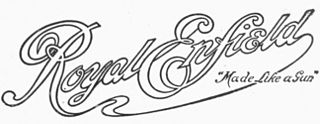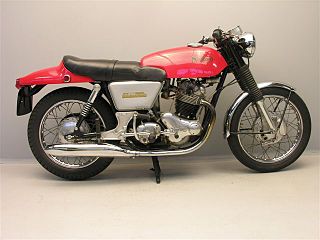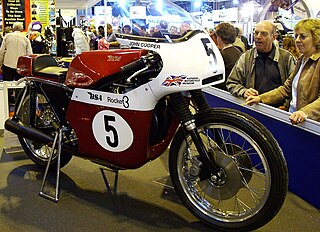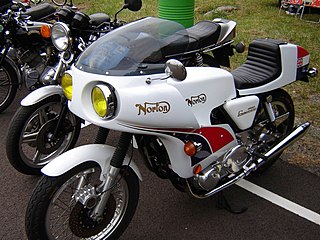
The Norton Motorcycle Company is a brand of motorcycles, originally based in Birmingham, England. This company is owned by Indian multinational giant TVS Motor Company. For some years around 1990, the rights to use the name on motorcycles was owned by North American financiers. From 2008 to 2020, a line of motorcycles was produced under owner and chief executive Stuart Garner. Due to financial failure with large debts, in April 2020 administrators BDO agreed to sell certain aspects of Garner's business to Project 303 Bidco Limited, a new business established for the purpose with links to Indian motorcycle producer TVS Motor Company.

A. J. Stevens & Co. Ltd was a British automobile and motorcycle manufacturer in operation from 1909 to 1931. The company was founded by Joe Stevens in Wolverhampton, England. After the firm was sold, the name continued to be used by Matchless, Associated Motorcycles and Norton-Villiers on four-stroke motorcycles till 1969, and since the name's resale in 1974, on lightweight, two-stroke scramblers and today on small-capacity roadsters and cruisers. The company held 117 motorcycle world records.

Royal Enfield was a brand name under which The Enfield Cycle Company Limited of Redditch, Worcestershire sold motorcycles, bicycles, lawnmowers and stationary engines which they had manufactured. Enfield Cycle Company also used the brand name Enfield without Royal.

Matchless is one of the oldest marques of British motorcycles, manufactured in Plumstead, London, between 1899 and 1966. A wide range of models were produced under the Matchless name, ranging from small two-strokes to 750 cc four-stroke twins. Matchless had a long history of racing success; a Matchless ridden by Charlie Collier won the first single-cylinder race in the first Isle of Man TT in 1907.

The Triumph Trident and BSA Rocket 3 was a technically advanced, high-performance roadster motorcycle made by Triumph Engineering and BSA from 1968 to 1975, and sold under both the Triumph and BSA marques. Alongside the Honda CB750, and later the Kawasaki triples, it brought a new level of sophistication to street motorcycles, marking the beginning of the superbike era. The Honda CB750 overshadowed the Trident to be remembered as the 'first superbike', in spite of the Triumph Trident actually debuting before the Honda by a few weeks.

The Ducati 750 Imola Desmo is a racing motorcycle built by Ducati that won the 1972 Imola 200 race in the hands of Paul Smart. This win helped define Ducati's approach to racing.
Norton-Villiers was a British motorcycle manufacturer formed in the 1960s following the collapse of AMC. With the general decline of the British motorcycle industry, under a British Government initiative it was later combined with the remnants of BSA Triumph to form Norton-Villiers-Triumph.

The Norton Commando is a British Norton-Villiers motorcycle with an OHV pre-unit parallel-twin engine, produced by the Norton Motorcycle company from 1967 until 1977. Initially having a nominal 750 cc displacement, actually 745 cc (45.5 cu in), in 1973 it became an 850 cc, actually 828 cc (50.5 cu in). It had a hemi-type head, similar to all OHV Norton engines since the early 1920s.

Peter Williams was a British former professional motorcycle racer. He competed in Grand Prix motorcycle road racing from 1966 to 1973. He also competed at many levels on home short-circuit races. He raced many times on the Isle of Man TT course from 1966 to 1973. His father was Jack Williams who ran the Associated Motor Cycles (AMC) race department. Williams trained in mechanical engineering and introduced via racing alloy wheels, an innovation which is commonplace on today's road bikes, and was also an early pioneer of solo-motorcycle disc brakes.
Frank Perris was a Canadian Grand Prix motorcycle road racer and TT rider from Toronto. Perris was noticed by the Suzuki team after his third-place in the 1961 500 cc World Championship, becoming a contracted-rider from 1962 until 1966. His best season was in 1965 when he won two 125cc Grand Prix races aboard a Suzuki two-stroke, and finished the year in second place in the 125cc world championship behind Hugh Anderson.

The featherbed frame was a motorcycle frame invented by the McCandless brothers and offered to the British Norton motorcycle company to improve the performance of their racing motorcycles in 1950. It was considered revolutionary at the time, and the best handling frame that a racer could have. Later adopted for Norton production motorcycles, it was also widely used by builders of custom hybrids such as the Triton, becoming legendary and remaining influential to this day.
The Navigator is a Norton motorcycle made from 1960 to 1965, based on the Norton Jubilee 250 cc. Production ceased shortly before the collapse of the parent group Associated Motor Cycles in 1966.

The Dunstall Norton was a Norton motorcycle made by Paul Dunstall, a specialist tuner of the 1960s and early 1970s twins originally using some parts from Norton's Domiracer project when the Birmingham factory was closed in 1963. In 1966 Dunstall Motorcycles became a motorcycle manufacturer in its own right so that Dunstalls could compete in production races, and set a number of world records before sales of the Dunstall Nortons declined in the 1970s consistent with the demise of the British motor cycle industry and a corresponding rise in Japanese imports.

The Norton P11 was a 745 cc (45.5 cu in) air-cooled OHV parallel twin motorcycle made by Norton-Villiers from 1967 to 1969. Designed as an extremely light high power-to-weight ratio desert racer, P11 was revised in 1968 to the P11A and marketed as the Norton Ranger, a road legal version of the P11 with a more comfortable seat to make it suitable for normal road use. The Norton P11 gained a reputation as a 'desert racer' in the late 1960s but by 1969 lighter two stroke desert racers began to dominate the sport and the Norton had begun Commando production and it was selling well. Norton ended production of the P11 series to concentrate on the Commando, which used a number of ideas developed on the P11 series.

The isolastic frame, designated by Norton as GlideRide, used a system of engine-to-frame mountings incorporating rubber bushes to isolate the vibration of the vertical twin engine from the frame and rider. The isolastic frame was developed for use with the Commando inclined engine, whilst the Featherbed frame continued in production for the Mercury with a softer-specification 650 cc vertical-engine until 1970.
Colin Jordan Seeley was a British motorcycle retailer who later became a motorcycle sidecar racer, motorcycle designer, constructor and retailer of accessories. In 1992 he was involved in running the Norton Rotary race team.

BSA motorcycles were made by the Birmingham Small Arms Company Limited (BSA), which was a major British industrial combine, a group of businesses manufacturing military and sporting firearms; bicycles; motorcycles; cars; buses and bodies; steel; iron castings; hand, power, and machine tools; coal cleaning and handling plants; sintered metals; and hard chrome process.

The BSA/Triumph racing triples were three cylinder 750 cc racing motorcycles manufactured by BSA/Triumph and raced with factory support from 1969-1974. There were road racing, production racing, endurance racing and flat track variants. The machines were based on the road-going BSA Rocket 3/Triumph Trident.

The John Player Norton, also referred to as JPN and JPS Norton, were a series of Formula 750 racers manufactured by Norton Motorcycle Company from 1972 to 1974 and sponsored by cigarette manufacturer John Player. The engine for these machines was derived from the unit used in the Norton Commando, which was a development of the 1948 Bert Hopwood designed 500 cc Dominator. The lack of power from the engine, compared with other manufacturers, led designer and rider Peter Williams to a adopt a radical approach to chassis design. Riders of the bikes included Williams, Phil Read, Tony Rutter, Mick Grant, John Cooper, Dave Aldana and Dave Croxford.

The Norton Commando John Player Special was a 1974 limited edition version of the Norton Commando that was fitted with bodywork styled to reproduce the successful Formula 750 works racers that were sponsored by cigarette manufacturers John Player & Sons. The machine was based on the Mk2A 850 Commando. Around 200 of these machines were made, of which about 120 were exported to the US. The bike was expensive, selling for around $3,000 in the US, $500 more than a standard Commando.
















